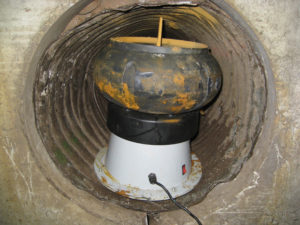Jul 26, 2018
New option emerges for rot control in potato storage
Wisconsin spud growers dealt with heavy rainfall and extreme heat at harvest during both of the past two growing seasons, which usually equates to disaster for potatoes in storage.
However, Dale Nelson, with Nelson Vegetable Storage of Plainfield, Wisconsin, said his growers were pleasantly surprised by the lack of deterioration when they removed their 2016 crop from storage. Their 2017 spuds also appear to be holding up better than expected. Nelson said the growers attribute their relatively good tuber quality to an innovative method of treating stored potatoes with chlorine dioxide gas. The Georgia-based company FoodDefend touts its patented product, FruitGard, as a longer lasting and more effective way to treat potatoes in storage for decay-causing pathogens such as pythium leak, bacterial soft rot, late blight, fusarium dry rot and silver scurf.
“We still get some hot spots in the pile, but it’s keeping them contained and drying them up,” Nelson said. “When we get into (potato) piles, by far I’ve had more success with this product.”
FoodDefend plant pathologist Thomas Young said the product, which got its EPA label for potatoes in 2010, should also receive a label for use in tomatoes and cantaloupe by August, followed by an expanded label for use on several other types of produce soon thereafter. In addition to preventing losses to rot, Young explained FruitGard also has great potential in the food-safety arena, as it kills harmful pathogens such as listeria, salmonella and E. coli. It’s already approved by FDA as a food-safety product for all fruits and vegetables bound for cutting or further processing prior to sale. Since the gas works without leaving a trace of residue, Young anticipates it will obtain organic certification soon after receiving its additional EPA approvals.
The conventional storage treatment for potatoes is peroxyacetic acid – a mixture of acetic acid and hydrogen peroxide in a watery solution. Some growers have also used a competing chlorine dioxide product formed by blending sodium chlorite with a liquid acid, and delivered through potato piles in water vapor.

dioxide, is intended to be a better option
in fighting storage pathogens like Pythium
leak, bacterial soft rot, late blight, fusarium
dry rot and silver scurf.
Young said FoodDefend’s innovation is using sodium chlorite and acids to produce a dry gas, which can be released either slowly or all at once. He said FruitGard does not cause corrosion to metal surfaces in storages, like the alternatives. It also more evenly treats the entire pile, as the dry chlorine dioxide gas rises until it selectively condenses upon contact with moisture-rich environments – mainly oozing wounds in potatoes. Nelson believes growers get the best control with FruitGard by applying a heavy dose at harvest and following up with drums that continually release trace amounts of the gas over a period of 90 days, making certain pathogens don’t reestablish themselves.
The product is typically blended in a cement mixer within the plenum of a potato storage, where high pressure forces the gas into spud piles through culverts below them. The gas is recirculated through the closed airflow systems of potato storages. FruitGard applicators also have the flexibility to target specific areas in storage through individual culverts. Nelson first began using the product about three seasons ago, starting with about a half dozen growers, all of whom increased their use of FruitGard during the following season.
He now works with about 100 spud growers who fill more than 200 storages throughout the U.S., mostly in the Midwest.
Track records in other crops
FruitGard has been thoroughly tested by several USDA and university researchers for use in potatoes and other produce. Young said researchers have been stunned by the effectiveness of treatments using relatively small doses of fumigant.
“Every researcher without exception had difficulty grasping the concept of the rate, because the concentration of the gas is below detection,” Young said.
Jerry Bartz, an emeritus professor with University of Florida, has studied it in tomatoes. Bartz found dry chlorine dioxide gas was among the most effective postinfection treatments for tomatoes, though he noted boxes used for shipping tomatoes can serve as a “sink” for the gas, and he advises using waxcoated boxes. Bartz said a significant benefit of using the dry gas is that it doesn’t introduce water to storages, which tends to exacerbate rot. In cantaloupe, Bartz believes FruitGard will deliver substantial food safety benefits, as the gas can penetrate through the webbing, which can harbor harmful bacteria.
Dave Paulshock, FoodDefend’s managing director, said spuds weren’t the company’s primary commercial focus until 2012, when he read an article describing how the U.S. potato industry loses millions in product annually to rot. “I didn’t realize the (potato) market was that big,” Paulshock said.
Nowadays, some of the largest potato farms in the world are using FruitGard. Paulshock said tomato, cantaloupe, onion and berry growers are also eagerly anticipating FruitGard’s forthcoming registrations. He anticipates application of FruitGard will eventually be standard practice throughout the tomato and melon industries.
“When you really weigh out the pros and cons, there’s really no comparison,” Paulshock said. “FruitGard products are uniquely suited to solve food-safety and sustainability challenges for the produce industry from farm to fork.”






